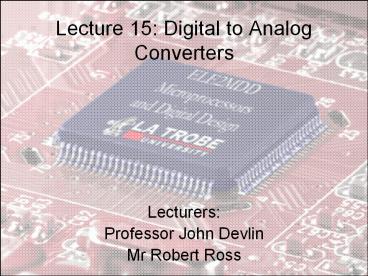Lecture 15: Digital to Analog Converters - PowerPoint PPT Presentation
1 / 18
Title:
Lecture 15: Digital to Analog Converters
Description:
Lecture 15: Digital to Analog Converters Lecturers: Professor John Devlin Mr Robert Ross Overview Introduction to DACs Types of DACs Applications of DACs Further ... – PowerPoint PPT presentation
Number of Views:488
Avg rating:3.0/5.0
Title: Lecture 15: Digital to Analog Converters
1
Lecture 15 Digital to Analog Converters
- Lecturers
- Professor John Devlin
- Mr Robert Ross
2
Overview
- Introduction to DACs
- Types of DACs
- Applications of DACs
- Further Reading
- R.J. Tocci, Digital Systems, Principles and
Applications, Prentice Hall (Chapter 10)
3
Interfacing with the analog world
4
Introduction DACs
- The real world is full of analog, continuous
signals - Microprocessors use digital electronics (discrete
binary values) for processing - Digital to Analog Converters (DAC or D/A) convert
discrete digital numbers into continuous-like
analog signals allowing digital electronics to
output real world analog signals - DACs are Mixed Signal Devices as they combine
analog circuits with DSP - Reverse of the operation of the ADC (Analog to
Digital Converter)
5
Digital to analog conversion
- Convert a digital value to a proportional current
or voltage. - Vref is used to set the full scale output.
6
DAC Specifications
- Resolution The smallest possible change that can
occur in the analog output due to a change in the
digital input (Step Size) - Offset Error Signal may be artificially offset,
yet remain linear - Linearity How much two adjacent analog values
deviate from the ideal 1LSB step
7
DAC Specifications
- Monotonicity Direction of change the same
input increases output increases
Monotonic Function
Non-Monotonic Function
8
Resolution
- Calculating the Resolution
Afs Analog full scale voltage n Number of bits
Resolution
9
Calculations
Afs Analog full scale voltage n Number of bits
Resolution
Analog Output K X Digital Input
Digital Input Analog Output / K
10
Types of DACs
- R-2R Ladder
- Pulse Width Modulation (PWM)
- Binary Weighted
- Thermometer coded
11
Pulse Width Modulation DAC
- Pulse Width Modulation (PWM)
- The duty cycle of a square wave is modulated,
thereby altering the average voltage of the
waveform - Period remains constant
12
R-2R Ladder
- Resistor Ladders (or R-2R Ladders) is the
simplest DAC - Operates as an array of voltage dividers
- Requires one output pin for each bit of
resolution - Requires well matched resistors
- Voltage spikes at major crossings (eg.
01111-gt10000)
13
Binary Weighted
- Contains a resistor for each bit of the DAC
- Resistors are arranged in binary decades
- All resistors fed into a summing point
- Difficult to produce with accurate resistors
for each binary bit
14
Binary Weighted
15
Thermometer coded
- A resistor or current source for each possible
value of the DAC Output - 8 bit DAC would have 256 resistors
- Fast and high precision, but very expensive
16
DAC Applications
- Audio
- CD Players
- MP3 Players
- Video
- DVD Analog TV
- Signal Generators
- Ramp Function
- Sine Wave
17
Waveform Generation
- Waveforms can be generated by supplying digital
representations of the desired analog output
18
Summary
- Digital to Analog converters allow digital
electronics to output signals which are similar
to real world continuous signals - Pulse Width Modulation is a simple and widely
used high resolution technique for implementing
DACs































